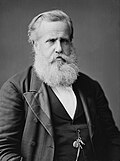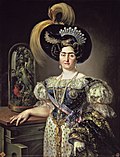This section has multiple issues. Please help improve it or discuss these issues on the talk page . (Learn how and when to remove these messages)
|

The descendants of John VI of Portugal , from the main branch of the House of Braganza, are present in several royal families across Europe and Brazil. Through his second son, Miguel I, some of his descendants have become rulers in Belgium, Luxembourg, and Liechtenstein, while others have been claimants to the thrones of Portugal, Austria-Hungary, and the former Duchy of Parma. Constitutional amendments regarding succession led to disputes throughout the nation following John VI's death. [1]
Contents
- Background
- Throne of Portugal
- Court in Rio de Janeiro
- Division of House of Braganza
- Descendants
- Maria Teresa of Braganza, Princess of Beira
- Francisco António of Braganza, Prince of Beira
- Maria Isabel of Braganza
- Pedro I & IV
- Maria Francisca of Braganza
- Isabel Maria of Braganza
- Miguel I of Portugal
- Maria da Assunção of Braganza
- Ana de Jesus Maria of Braganza
- See also
- References







































